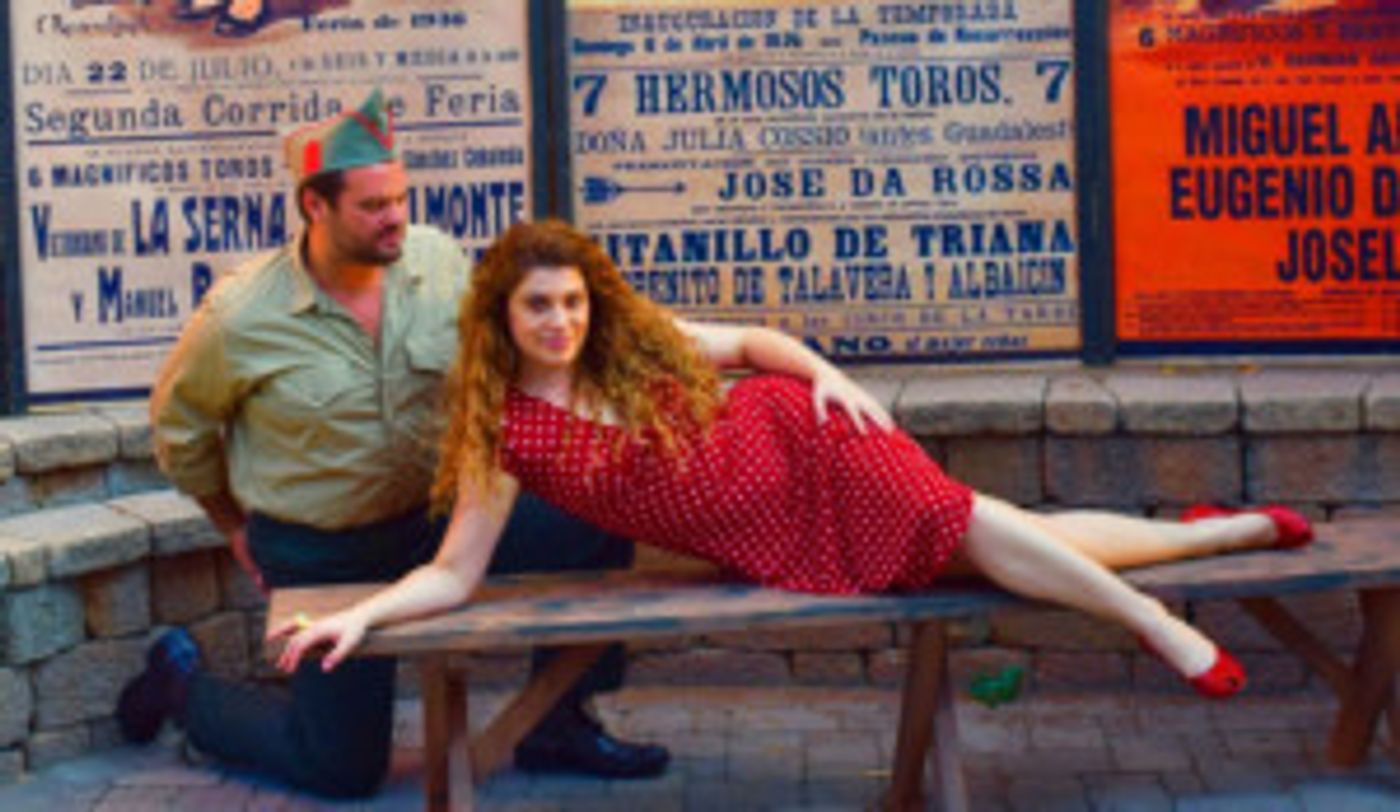Review: CARMEN at John Anson Ford Amphitheatre

On Saturday, September 1, 2018, Pacific Opera Project presented Georges Bizet's Carmen at the John Anson Ford Amphitheatre in Los Angeles. Michael Powers conducted a full-blooded rendition of the overture as the sun set behind the hillside with its ancient trees and a bedraggled Don José was led before a firing squad.
The Carmen was sex-kitten Nora Graham-Smith who has sung with significant opera companies in Europe. Her soldier-lover, Don José, was heroic voiced Dane Suarez who will sing Pinkerton in Madama Butterfly and Canio in Pagliacci with Opera San Jose next season. Both were closely miked, as were all the soloists in this performance, and that method of amplification did not allow for any bloom on the voices as they spread out into the theatre.
Since the opera was performed in an open-air theater, the venue's natural backdrop and rocky outcroppings formed much of the scenery. The main scenic additions for the opera were tables, chairs, posters, and an occasional gauze curtain to suggest an indoor setting. Maggie Green's costumes set the story in the present time and thus denied the audience the chance to reminisce with the dress of an earlier period. I particularly missed the flying and whirling skirts that can often be seen when the Gypsy women fight in the first act and dance in the second.
The amphitheatre's stage was both broad and deep, giving the artists, especially Stage Director Josh Shaw, a large area on which to tell the Gypsy's story. His Carmen was an interesting young woman. She had a violent temper and she cut a large gash on a fellow factory worker's face, but she really fell in love, first with Don Jose and not long after that with Escamillo. She believed what her cards told her and, unfortunately, she never expected she could escape her fate.
Graham-Smith has a complex voice that I would have liked to hear indoors without the microphone. After an uneven rendition of the "Habanera," her "Seguidilla" showed more of her range and the darker tones so appropriate for Carmen's character. Those dark and plum-colored sounds made her "Card Song" one of the best solos of the evening.
One of Shaw's main contributions was his version of the score. By omitting much of the dialogue, he was able to give his audience a great deal more of Bizet's wonderfully melodic music than we usually hear in the opera house. One of these days I hope some musicologist will sort through the piles of music that is Carmen and give us a definitive version.
As Don José, Dane Suarez sang with strong, resonant tones, but on occasion he seemed troubled by the microphone. He gained vocal momentum throughout the evening, however, as his character developed toward the final act's inevitable murder. Babatunde Akinboboye was an exciting Escamillo who thrilled the entire audience with his "Toreador Song" and his last act Spanish flag-waving entry into the theater as the victorious matador of Granada.
As Carmen's Friends, Frasquita and Mercedes, Katherine Powers and Maria Dominique Lopez kept the action flowing as did William Grundler and Joel David Balzun who sang Remendado and Dancairo. Powers also functioned as the chorus master and her group sang with pleasant harmonies. Sara Salazar's Children's Chorus also sang in tune and looked positively adorable.
The voice of Shaw's frequent fight coordinator, Aubrey Trujillo-Scarr, soared above the orchestral textures as the frightened but determined Micaela. Although she had been severely harassed by the soldiers in the first act, she braved the dangers of the border as she again searched for Don José to tell him his mother was dying. Her third act aria showed her character's ability to combine fear with courage.
Shaw is building an orchestra. He already has a valuable concertmaster in Madalyn Parnas Moller and among his thirty-three players, he noted several as principals for their instruments. Maestro Michael Powers led this group in a well-paced rendition of the score that never let the tension sag. This was a performance that placed more emphasis on the visual than on the aural, but it resulted in a Carmen the Ford Amphitheatre audience appreciated and applauded vociferously.
Photo by Martha Benedict
Reader Reviews
Videos

